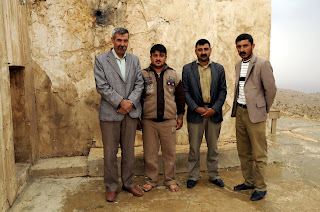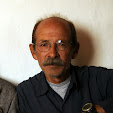26 October 2012 - There is an
annual celebration – a tawaaf – held at every Yezidi
temple. It is an occasion to celebrate not only the Yezidi religion,
but the community as well, remembering that the Yezidis remain a
marginalized, if not persecuted, hyper-minority among the Kurds and
in the “middle east.”
Gharbi, Xider, and I had just driven
across the west end of Sinjar Mountain, paralleling the Iraq-Syrian border. Gharbi had
been told that the tawaaf at Sheikh Ali Shemsa temple
is to be today, and we hastened our pace to attend.
Not but 3 kilometers off the main road
we see the scrum of cars; Xider turns and follows the pot-holed tracks bumpling through the parchment. I can see the temple's spire, and as we got closer,
I notice with measured attention, human figures not only on the
temple's roof, but up the fluted spire as well. Experiences at
Lalish's annual gathering, jemaiyaii, have taught me that
Yezidis can have an exuberant attitude towards their religious sites,
some would say irreverent in appearances, but to climb the spire?

Xider parks the car in the helter skelter and we walk towards the temple. There is a rickety scaffolding upon which the
young men perch precariously. They are replastering the entire structure in a gleaming white plaster; only the top quarter of the spire remains earthen brown. Mixed one dish at time, the
lime paste is passed hand-to-hand from base of the temple, up the
ladder, and into the hands of a square man cutting an imposing figure
in his red-and-white checkered kaffiya against the blue sky. He raises the dish each
time received, makes a proclamation to which the crowd joyfully responds, and
passes it up the human chain to the one teetering at the top who spreads
the paste with his hand. When in the day they began this herculean
effort I do not know, but it is not until 2 hours later that it is
completed to a roar of approval.

All the while, crowds stream into the
small temple, littering their shoes outside of the doorway. The
mejewer and other men commanding religious respect, sit on
cushions in the outer chamber, smoking cigarettes and talking as the
faithful squeeze through. As the pilgrims enter the inner sanctum,
they leave a gift of money on the threshhold which the mejewer
deftly scrapes up and tucks in his robe in a single motion. The
pieces of brightly colored silk cloth endure thousands of
knots tied and untied. Many wishes should be fulfilled today.

A short distance away a larger throng
of Yezidis compress under the deafening din of live music powered by
a generator in the back of a pick-up truck. The young musicians sit
on lime green plastic chairs, their traditional rhythmic music
screeching and squawking as the surrounding circle of 200 dancers
hold hands straight-armed and move their feet in united restraint. A
cluster of women in the traditional dress of white robes and black
jackets, topped by white head scarves or oversized buns, watch
impassively.
As I think that the tawaaf is
complete in its relentless energy, a parade of Yezidis approach from
another direction. It is the pari sewarkeren (the
carrying of the fabric) ceremony. The silk cloth in the
temple is replaced during the tawaaf at each temple. Even fabric can only grant so many wishes.
The afternoon grows late. Gharbi,
Xider, and I retreat to the car for the hour longdrive back to Gharbi's
home. I sit tiredly in the back seat, smiling. It has been a good return to the Sinjar; a good
journey indeed.





















